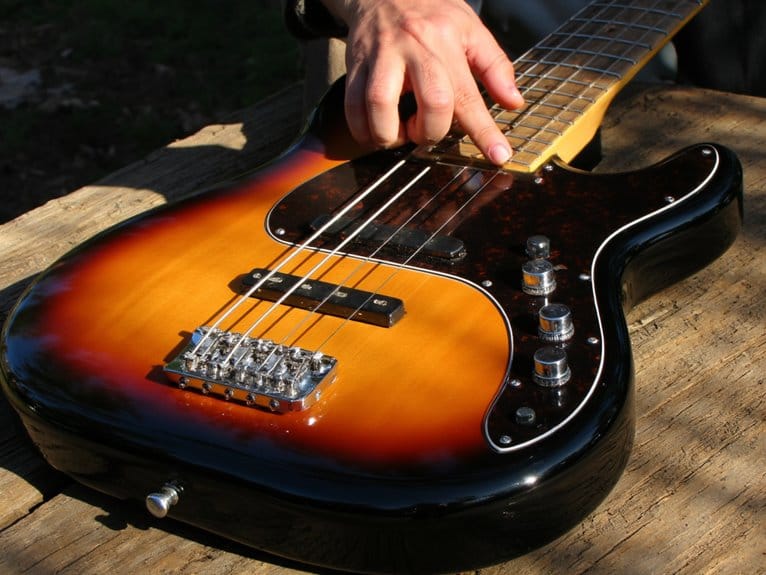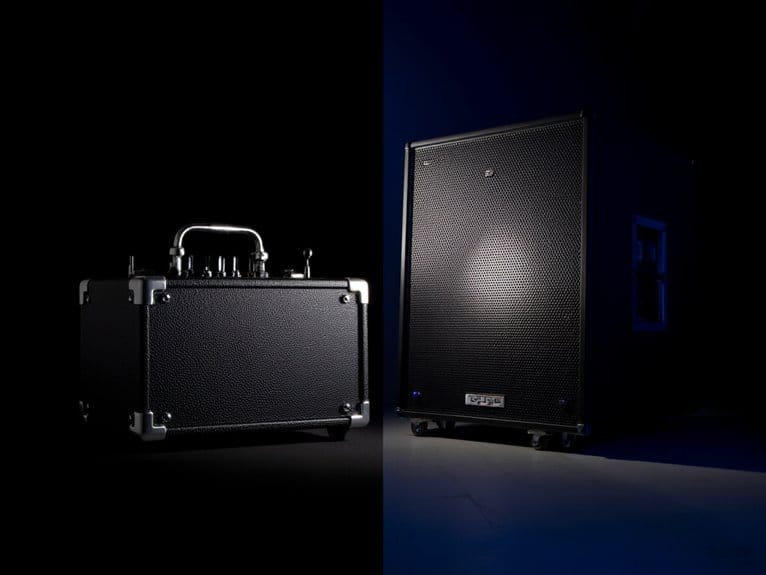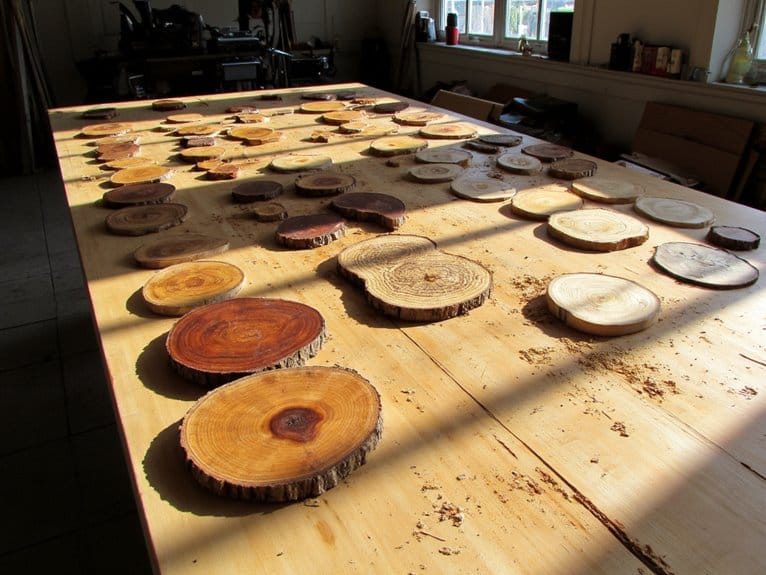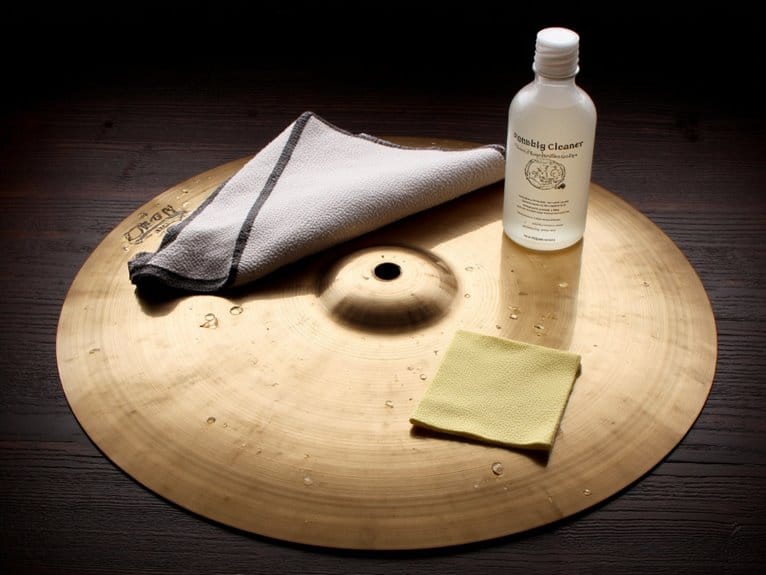How to Choose Your First Bass Guitar: Beginner’s Guide
When choosing your first bass guitar, start with a four-string model featuring a standard 34-inch scale length and comfortable C-shaped neck profile, which reduces hand fatigue while providing the classic low-end punch that rock bassists favor. Budget around $200-500 for the instrument itself, plus an additional $250-700 for essential accessories like a practice amplifier, quality shielded cables, protective case, and headphones that enhance your tonal awareness during practice sessions. The complete guide below reveals advanced techniques for matching pickup configurations to your preferred musical style.
We are supported by our audience. When you purchase through links on our site, we may earn an affiliate commission, at no extra cost for you. Learn more.
Notable Insights
- Set a clear budget of $200-500 for the bass, plus $250-700 for amplifier and essential accessories.
- Choose a standard four-string bass with 34-inch scale length for easier learning and versatile sound options.
- Test body size and neck comfort while sitting and standing to ensure proper ergonomics and playability.
- Match pickup style to your music genre: P-bass for rock/blues, J-bass for funk/jazz, or PJ for versatility.
- Shop strategically by testing multiple instruments in stores, checking for fret buzz, and considering quality secondhand options.
Setting Your Budget and Understanding Costs
The first major decision you’ll face when choosing your bass guitar isn’t actually about the instrument itself—it’s determining how much you’re willing to invest in your musical journey, and frankly, this decision will shape every other choice you make along the way.
Your budget isn’t just about money—it’s about defining your commitment to bass guitar and setting the foundation for everything that follows.
When establishing your budget priorities, I recommend allocating $200-500 for the instrument itself, though quality beginner basses start around $200 where you’ll find decent sound and tuning stability. High-quality instruments are available for a couple of hundred dollars, making excellent bass guitars more accessible than many beginners initially expect. Bass guitar prices span a wide range from under $150 to over $1,500, so establishing a clear budget becomes essential before you start shopping. The Fender Squier Debut Precision Bass at $130 demonstrates how authentic design and classic P-bass sound can be achieved at budget-friendly prices.
Your cost breakdown should include the bass, amplifier ($100-300), cables, straps, and accessories, which easily adds another $150-400 to your total investment. Complete starter packages under $200 include amplifiers, cases, and all necessary accessories for immediate play, making them an excellent value proposition for new players. However, keep in mind that initial setup adjustments are often necessary for optimal performance, regardless of your budget range.
Starter packs often provide better value by bundling these essentials, though individual component selection offers more customization flexibility for your specific needs.
Choosing the Right Number of Strings and Scale Length
When you’re selecting your first bass guitar, you’ll need to decide between the standard four-string configuration and models with additional strings, each offering distinct advantages depending on your musical goals and physical comfort.
The scale length, which measures the vibrating string distance from nut to bridge, directly impacts playability and tone quality, with common options including 32-inch short scale, 34-inch standard, and 35-inch long scale designs. The standard four-string bass features open string notes tuned to E, A, D, and G from lowest to highest pitch.
These two fundamental specifications work together to determine your instrument’s overall feel, tonal characteristics, and suitability for different playing styles, so understanding their implications will help you make an informed choice. The standard 34-inch scale length strikes an optimal balance between string tension and low-end punch, making it the most popular choice among rock bassists. As you develop your skills, you may want to enhance your bass’s natural tone with a preamp pedal that offers versatile EQ controls and sound customization options.
Additionally, consider that your bass guitar choice will influence your amplifier needs, as bass amps require specific features to properly project your instrument’s low-frequency output in various performance settings.
Four Strings Vs More
As you stand in the music store contemplating your first bass guitar, one of the most fundamental decisions you’ll face involves choosing between a traditional four-string bass and its extended five-string counterpart, each offering distinct advantages that can greatly impact your learning journey and musical development.
Four string advantages include narrower necks with comfortable string spacing, making finger placement easier while you’re developing foundational techniques, plus lighter gauge strings that reduce finger strain during those inevitable marathon practice sessions.
Five string versatility shines through extended low-end range via the additional B string, covering metal, jazz, and gospel styles without repositioning your hand as frequently, though you’ll need to adapt to wider necks and potentially challenging string spacing that some luthiers compress to maintain playability. Similar to how cardioid patterns help microphones isolate sound sources, proper string spacing on your bass helps isolate individual notes for cleaner playing. Consider how the weight of your instrument choice will affect portability when transporting your bass to lessons and practice sessions.
For beginners wanting to explore extended range playing, the Ktaxon 6 String Electric Bass Guitar offers dual humbucker pickups and comes with a complete accessory package to get you started.
Scale Length Options
Beyond selecting the right number of strings, you’ll need to understand scale length—a measurement that determines how your bass feels under your fingers and sounds through your amplifier.
Scale length, measured by doubling the distance from nut to the 12th fret, directly affects string tension, fret spacing, and overall tone characteristics.
Short scale basses (30-32 inches) offer lower string tension, warmer tones, and closer fret spacing that’s perfect for smaller hands or beginners seeking comfortable playability.
Long scale basses (34-36 inches) provide higher string tension, brighter articulation, and the traditional bass sound most players recognize.
Your physical comfort matters more than you might think—short scale instruments feel considerably different under your hands, while long scale options deliver that snappy, punchy tone you’ve heard on countless recordings.
Finding the Perfect Body and Neck Size for Comfort
The journey toward bass guitar mastery begins with finding an instrument that feels like a natural extension of your body, and I’ve learned through years of playing that comfort isn’t just a luxury—it’s absolutely crucial for developing proper technique and maintaining practice motivation.
When selecting your first bass, prioritize body shape and neck profile over flashy aesthetics, because an uncomfortable instrument will quickly derail your progress. Test different body sizes while sitting and standing to verify the bass doesn’t obstruct your fretting hand or cause awkward positioning.
Pay attention to neck width—four-string basses offer narrower profiles that accommodate smaller hands better than five or six-string configurations. The neck profile’s curvature should allow relaxed elbow positioning when reaching the first fret, preventing strain during extended practice sessions.
Look for instruments featuring a comfortable C-shaped neck, which provides an ergonomic profile that reduces hand fatigue and allows for better finger positioning across the fretboard. Consider the overall body weight as well, since an ideal range between 8 to 11 pounds minimizes discomfort during prolonged playing sessions.
Many beginner-friendly models offer lightweight design specifically tailored for younger players or those developing their playing endurance.
Matching Sound and Style to Your Musical Preferences
Once you’ve settled on the physical comfort aspects of your bass, discovering your sonic identity becomes the exciting next challenge, and I’ll admit that choosing between the myriad tonal possibilities can feel overwhelming when you’re starting out.
Your bass sound needs to complement your musical style, whether you’re drawn to rock’s punchy aggression or jazz’s bright versatility. P basses deliver thick, punchy tones perfect for rock and blues, while J basses offer brighter, more articulate sounds favored in funk and jazz.
If you’re unsure about your direction, PJ-style basses combine both pickup types, giving you access to a broader tonal palette. Consider that split-coil designs reduce electrical hum while maintaining excellent tonal output, making them particularly reliable for live performances and recording situations.
Entry-level models emphasize ease of use over complexity, making them ideal starting points for beginners who want to focus on learning fundamentals rather than navigating complicated controls. Budget-conscious musicians can find excellent instruments under $300 that balance cost with professional quality, allowing you to develop your skills without financial strain.
Essential Accessories Every Beginner Needs
When you’re starting out, I’ve found that certain accessories aren’t just helpful additions, they’re absolutely vital for developing proper technique and protecting your investment in the instrument.
Your amplifier becomes your sonic canvas, working alongside quality audio cables to deliver clean signal transmission from bass to speaker, while electronic tuners guarantee you’re always playing in pitch during those critical early practice sessions. For beginners, a practice amp in the 10 to 20 watt range provides the perfect balance of volume for personal practice while offering headphone capabilities for silent sessions.
Protective cases and gig bags might seem like afterthoughts, but they’ll save you from costly repairs when you inevitably bump your bass against doorframes, music stands, or that coffee table you swore you’d moved out of the way.
Quality headphones with 50mm neodymium drivers can enhance your practice sessions by delivering the deep bass response essential for hearing your instrument’s full frequency range and developing your ear for proper tone.
As you advance in your playing, consider adding a DI box to your setup, which provides professional signal conversion and eliminates buzz and hum when connecting your bass directly to recording equipment or mixing boards.
Amplifiers and Audio Cables
Bass amplification represents one of your most essential gear decisions after selecting your instrument, and I’ve learned through years of helping beginners that choosing the right amp-and-cable combination can make or break your early playing experience.
Understanding amplifier types—solid-state, tube, hybrid, and combo configurations—helps you navigate power ratings from 15-30W practice amps to 100W+ performance models.
Your starter setup should prioritize these fundamentals:
- EQ controls (bass, mid, treble) for tone shaping across different genres
- Multiple inputs including auxiliary connections for backing tracks
- Quality shielded cables with 1/4-inch connectors, typically 10-20 feet long
The Fender Rumble series, Ampeg Rocket Bass, and Boss Katana Bass offer excellent beginner-friendly features. The Rumble models are particularly appealing for beginners due to their lightweight design at just 21-22 pounds, making them easy to transport between practice spaces, and their built-in overdrive circuits that allow you to explore both clean and gritty tones as your playing develops.
Cable quality directly impacts your sound clarity, so invest in proper shielding to reduce interference and right-angle connectors for tight spaces. For those planning to record their bass playing later, affordable audio interfaces under $200 can help achieve professional sound quality when connecting your amp to a computer for home recording sessions.
Tuners and Protective Cases
Your amplifier won’t do you much good if your bass sounds off-pitch, and I’ve watched countless beginners struggle through practice sessions with instruments that drift out of tune faster than they can play through a simple scale progression.
Clip-on bass tuners offer the most beginner-friendly solution, attaching directly to your headstock while detecting string vibrations accurately, even in noisy practice rooms where smartphone apps might fail you. I recommend models that can handle low E-string frequencies reliably, since cheaper tuners often struggle with bass-specific frequencies.
Equally important, protective cases safeguard your investment from humidity changes, scratches, and transport damage that affect tuning stability. Start with a quality gig bag for portability, then upgrade to hard-shell cases as your gigging frequency increases.
Smart Shopping and Learning Strategies for New Players
Since I’ve guided countless beginners through their first bass purchase over the years, I can tell you that success depends heavily on approaching the process with a clear strategy rather than wandering into a music store unprepared.
My most effective shopping tips focus on hands-on evaluation: visit multiple stores to compare instruments, inspect for fret buzz and loose hardware, and prioritize comfort over aesthetics.
Don’t rush into impulse purchases based solely on appearance.
Essential learning resources include:
- Online tutorials and bass tabs for structured skill development
- Tuning apps and metronome tools for technical foundation building
- Local teachers or bass communities for personalized guidance and motivation
Consider secondhand instruments from reputable sources to maximize quality within your budget, and remember that consistent daily practice with proper finger technique matters more than expensive gear when you’re starting out.
Frequently Asked Questions
How Often Should I Change My Bass Guitar Strings?
You should change your bass strings every 3-4 months for ideal string longevity. However, your changing frequency depends on playing style, tone preferences, and budget—some players change weekly while others never do.
What’s the Difference Between Fretted and Fretless Bass Guitars for Beginners?
Fretted advantages include easier learning with tactile note divisions and forgiving finger placement, while fretless challenges involve demanding precise positioning and advanced ear training that’ll considerably steepen your learning curve as a beginner.
Should I Learn to Play With a Pick or Fingerstyle Technique?
You should experiment with both pick technique and fingerstyle technique initially. Pick technique offers brighter attack and easier shift from guitar, while fingerstyle technique provides warmer tone and greater dynamic control for versatile playing.
How Do I Properly Maintain and Clean My Bass Guitar?
You’ll need proper cleaning techniques like wiping strings with microfiber cloths after playing and using specialized string cleaners. Essential maintenance tips include conditioning your fretboard regularly and polishing the body to prevent damage.
On a final note
You’re now equipped with the knowledge to make an informed first bass purchase, from understanding how budget constraints affect quality levels to recognizing which body dimensions, string configurations, and tonal characteristics align with your musical aspirations. Don’t overthink the decision—while specs matter, your enthusiasm for playing matters more. Start with something comfortable and affordable, then let your developing skills and evolving preferences guide future upgrades.







